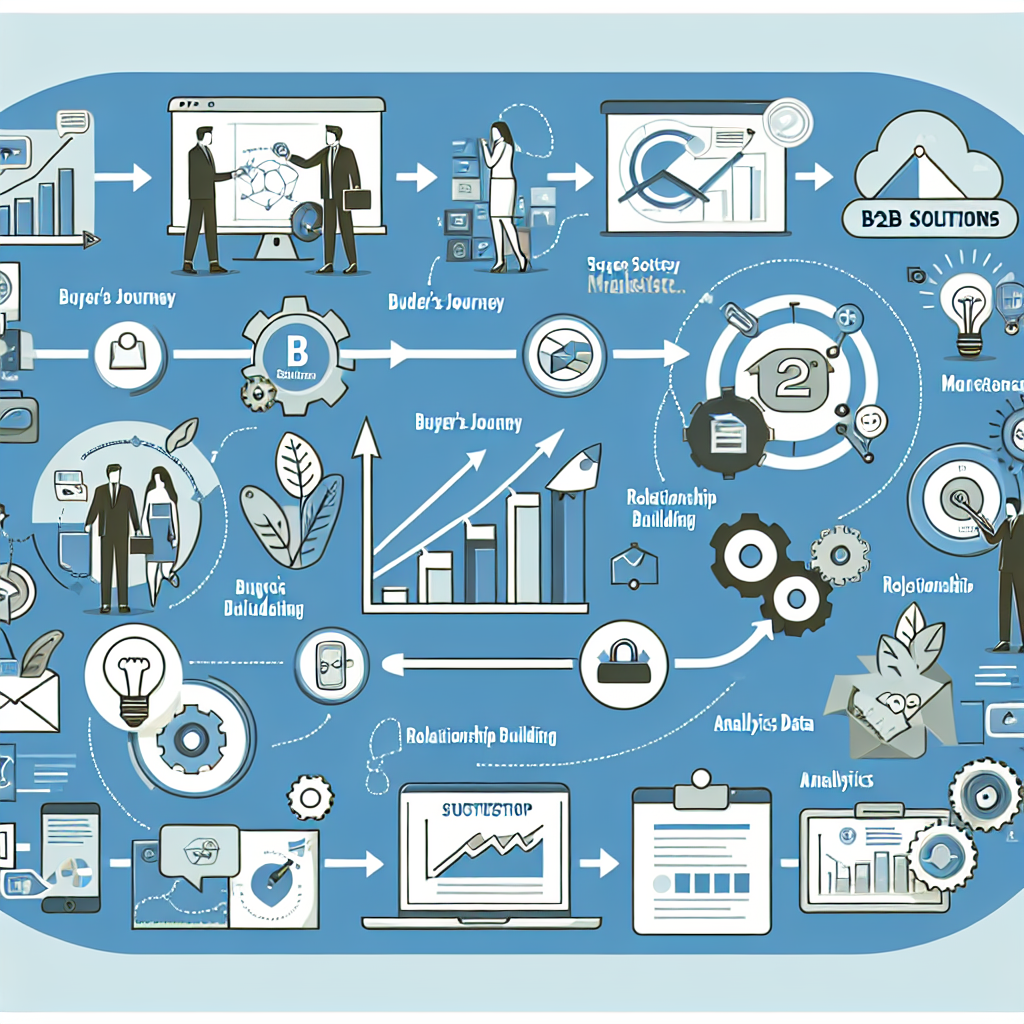Solutions Marketing: The Art of Solving Customer Pain Points
Introduction
Welcome to the world of solutions marketing, where we don’t just sell products we solve problems! Imagine walking into a store, and instead of being bombarded with flashy ads and pushy salespeople, you’re greeted by a friendly guide who genuinely wants to understand your needs. That’s the essence of solutions marketing: it’s all about addressing customer pain points and delivering tailored solutions that make their lives easier.
In today’s competitive landscape, especially in B2B settings, companies must embrace a customer-centric solutions marketing approach. This means shifting from traditional selling tactics to a more strategic mindset focused on understanding and alleviating the challenges faced by customers. Whether it’s leveraging analytics for data-driven decisions or employing innovative tactics for customer engagement, the goal is clear: create value.
But what does it take to craft an effective solutions marketing strategy? It requires a blend of creativity, technology, and a deep understanding of your audience’s needs. Think of it as assembling a puzzle each piece represents different components like personalized messaging, integrated marketing solutions, and omnichannel strategies that come together to form a cohesive picture.
As we dive deeper into this blog post, we’ll explore key components of successful solutions marketing strategies, innovative approaches that are reshaping the industry, and best practices for aligning sales and marketing efforts. So buckle up! Let’s embark on this journey to unlock the art of solving customer pain points through effective solutions marketing!

Understanding Solutions Marketing
So, what exactly is solutions marketing? At its core, it’s a strategic approach designed to address and solve specific customer pain points through tailored offerings. Think of it as a superhero swooping in to save the day only instead of capes, we have data, insights, and a sprinkle of creativity!
The importance of addressing customer pain points cannot be overstated. In today’s fast-paced market, customers are not just looking for products; they crave solutions that fit their unique challenges. A well-crafted solutions marketing strategy ensures that businesses align their offerings with these needs, creating a win-win scenario. When customers feel understood and valued, they are more likely to engage and remain loyal.
Did you know? Companies that excel in solutions marketing see a significant boost in customer engagement and retention rates. It’s not just about selling; it’s about building relationships!
The landscape of solutions marketing is continuously evolving, especially with the rise of digital solutions marketing. From personalized strategies to technology-driven tactics, businesses are leveraging innovative solutions marketing techniques to reach their audience effectively. This means utilizing data-driven insights to create targeted solutions that resonate with potential buyers.
Key Trends in Solutions Marketing
- Customer-Centric Focus: Businesses are shifting from product-centric to customer-centric approaches, ensuring that every solution meets specific needs.
- Integrated Marketing Solutions: The use of multi-channel and omnichannel strategies allows for seamless customer experiences across platforms.
- Agile Solutions Marketing Approach: Companies are adopting more flexible tactics that can quickly adapt to changing market demands.
Mistakes to Avoid
- Ignoring Customer Feedback: Failing to listen can lead to missed opportunities for improvement.
- Siloed Departments: Lack of collaboration between sales and marketing teams can hinder success.
- Pushing Products Instead of Solutions: Customers want answers not just a sales pitch!

In summary, understanding solutions marketing is about recognizing the evolving needs of your customers and crafting strategies that address those needs head-on. By embracing a holistic approach integrating various tactics like content-driven campaigns and leveraging analytics you’ll be well on your way to mastering the art of solving customer pain points!
Key Components of a Solutions Marketing Strategy
When it comes to solutions marketing, having a well-thought-out strategy is like having a treasure map without it, you might end up wandering in circles! Here are the key components that will guide your journey:
- Identifying Customer Pain Points and Needs: The first step is to put on your detective hat. What keeps your customers up at night? Conduct surveys, hold focus groups, or simply engage with them on social media. Understanding their struggles is crucial for developing effective solutions marketing strategies.
- Developing a Customer-Centric Approach: Think of your customers as the stars of your show. A customer-centric approach means putting their needs at the forefront of your strategy. This involves tailoring your offerings and communication to resonate with them personally. Remember, people don’t just buy products; they buy solutions to their problems!
- Creating Effective Messaging that Resonates: You’ve identified the pain points and developed a customer-centric approach now it’s time to craft messaging that strikes a chord. Your messaging should not only inform but also inspire action. Use storytelling techniques to connect emotionally and illustrate how your solutions can alleviate their pain points.
- Leveraging Data-Driven Insights: In today’s digital landscape, data is your best friend. Utilize analytics tools to gather insights about customer behavior and preferences. This will help you refine your strategies for better targeting and engagement in your solutions marketing efforts.
- Implementing Multi-Channel Strategies: Don’t put all your eggs in one basket! An effective solutions marketing strategy should deploy multi-channel tactics think email campaigns, social media outreach, webinars, and content marketing to reach customers where they are most active.
- Aligning Sales and Marketing Efforts: Collaboration is key! Ensure that sales and marketing teams are aligned on goals and messaging. Regular check-ins can help both teams stay informed about customer feedback and adjust strategies accordingly for maximum impact.
Tip: Regularly revisit these components as market conditions change or new technologies emerge!

B2B Solutions Marketing: Tailoring Strategies for Business Clients
When it comes to B2B solutions marketing, understanding the nuances of your business clients is crucial. Think of it as being a tailor, where every stitch counts in creating a perfectly fitted suit for your customers. Let’s dive into how you can craft strategies that not only resonate but also drive results.
Understanding the B2B Buyer’s Journey
The B2B buyer’s journey is like a thrilling roller coaster ride filled with ups, downs, and unexpected twists. Unlike B2C buyers who often make snap decisions based on emotion, B2B clients take their time, weighing every option before making a purchase. They typically follow these stages:
- Awareness: They realize they have a problem that needs solving.
- Consideration: They research potential solutions and compare options.
- Decision: They choose a solution that meets their needs and aligns with their business goals.
Building Relationships Through Trust and Value Delivery
In the realm of B2B solutions marketing, relationships are everything. Your clients are not just looking for a product; they want to partner with someone who understands their challenges and can deliver value consistently. Here are some strategies to foster those relationships:
- Personalized solutions marketing: Tailor your offerings based on client needs and preferences.
- Effective communication: Keep lines open be it through newsletters, webinars, or one-on-one meetings.
- Value-driven content: Provide insights that help them solve problems even before they become customers.
Case Studies of Successful B2B Solutions Marketing Efforts
If you’re wondering what success looks like in this field, let’s take a peek at some companies that have nailed it:
Case Study 1: HubSpot
Their inbound marketing strategy is all about providing valuable content that addresses pain points across different stages of the buyer’s journey. This approach has helped them become leaders in the CRM space.
Case Study 2: Salesforce
Their customer-centric approach focuses on building long-term relationships rather than just closing deals. Their success lies in understanding client needs and delivering tailored solutions accordingly.
Avoiding Common Misconceptions
A common pitfall in B2B solutions marketing is assuming that every business client has the same needs. Remember, each company is unique! Avoid cookie-cutter strategies that fail to address specific challenges faced by individual clients. Instead, leverage analytics to gain insights into customer behavior and preferences this will inform your tailored strategies effectively.

The Takeaway
B2B solutions marketing isn’t just about selling; it’s about creating lasting partnerships through trust and value delivery. By understanding the buyer’s journey and tailoring your approaches accordingly, you can position yourself as a trusted advisor rather than just another vendor. So roll up those sleeves and start crafting personalized strategies today!
Innovative Approaches in Solutions Marketing
Welcome to the front lines of solutions marketing, where creativity meets strategy! In an age where consumers are bombarded with options, standing out requires more than just a catchy slogan. It demands innovative approaches that not only address customer pain points but also engage them in ways they never saw coming.
Leveraging Technology for Data-Driven Solutions Marketing
Imagine having a crystal ball that reveals exactly what your customers want. Well, with technology and data analytics, you can get pretty close! By leveraging data-driven solutions marketing, businesses can analyze customer behaviors and preferences to tailor their offerings like a bespoke suit.
- Predictive Analytics: Use historical data to forecast future buying behaviors. This is like having your own weather forecast, but for sales!
- Customer Segmentation: Divide your audience into targeted groups based on their needs. Think of it as creating personalized playlists for every customer vibe.
- A/B Testing: Experiment with different marketing messages or channels to see what resonates best. It’s the ultimate marketing science fair!
The Role of Analytics in Optimizing Strategies
Analytics is the secret sauce that transforms raw data into actionable insights. With the right tools, you can measure everything from engagement rates to conversion metrics, allowing for real-time adjustments to your strategies. It’s like being able to adjust your sails while sailing if the wind changes direction, so do you!
Key Insight: Companies that adopt a data-driven approach in their solutions marketing strategy report up to 5 times higher ROI compared to those who don’t leverage analytics.
Creative Solutions Marketing Tactics to Engage Customers Effectively
If you want to capture attention in today’s crowded marketplace, it’s time to think outside the box or even throw the box away entirely! Here are some creative tactics that can make your solutions marketing pop:
- Interactive Content: Quizzes, polls, and interactive infographics can engage customers and provide them with personalized feedback.
- User-Generated Content: Encourage customers to share their experiences with your products. Nothing beats authentic testimonials from real users!
- Nostalgia Marketing: Tap into emotions by referencing past trends or cultural moments. Who doesn’t love a good throwback?
A New Perspective on Customer-Centric Solutions Marketing
This isn’t just about selling; it’s about building relationships. Adopting a truly customer-centric approach means understanding not just what customers want but why they want it. This holistic view enables brands to create solutions that resonate deeply and foster loyalty.
The key takeaway here? Embrace innovation in every aspect of your solutions marketing efforts from analytics and technology integration to engaging content strategies. The more you adapt and evolve, the better equipped you’ll be to solve those pesky customer pain points effectively!
The Role of Integrated and Omnichannel Solutions Marketing
In the world of solutions marketing, the days of siloed strategies are as outdated as dial-up internet. Today, businesses need to embrace integrated and omnichannel solutions marketing to truly resonate with their customers. But what does that even mean? Let’s break it down!
Defining Integrated Marketing Solutions and Their Benefits
Integrated marketing solutions are all about creating a cohesive experience across various channels. Think of it as a symphony where every instrument plays in harmony rather than a chaotic jam session. When companies utilize an integrated approach, they can:
- Deliver consistent messaging across all platforms.
- Enhance brand recognition and trust.
- Improve customer engagement through personalized experiences.
The Significance of an Omnichannel Approach in Customer Engagement
An omnichannel approach takes integration a step further by ensuring that the customer experience is seamless, regardless of the channel they choose to engage with. Imagine shopping for shoes: you might start on your phone during your morning coffee, switch to your laptop at work, and then finalize the purchase on your tablet while lounging on the couch. A successful omnichannel strategy means that each touchpoint feels like part of one fluid journey.
Best Practices for Implementing Integrated Campaigns Across Channels
So how do you actually make this integrated and omnichannel magic happen? Here are some best practices:
- Leverage Customer Data: Use analytics to understand customer behavior across channels. This data-driven solutions marketing approach allows you to tailor messages effectively.
- Create Cohesive Content: Ensure your messaging is not only consistent but also relevant across platforms. This means customizing content for social media, email, and websites while keeping your core message intact.
- Engage Cross-Functional Teams: Foster collaboration between sales, marketing, and customer service teams to align goals and strategies. A cross-functional team for solutions marketing can drive better results!
- Test and Optimize: Regularly analyze campaign performance metrics to refine your strategies continuously. This agile solutions marketing approach keeps you responsive to market changes.
In conclusion, embracing integrated and omnichannel solutions marketing is not just a trend; it’s a necessity for brands looking to thrive in today’s competitive landscape. By focusing on creating cohesive experiences that meet customers where they are, brands can enhance engagement, drive loyalty, and ultimately solve those pesky pain points more effectively.
Aligning Sales and Solutions Marketing Efforts for Better Results
Picture this: your sales team is like a finely tuned sports car, revving to go, while your solutions marketing team is the pit crew, ready with innovative strategies and tools. But if they aren’t in sync, that car isn’t going anywhere fast! Aligning these two powerhouse teams can be the turbo boost your business needs to drive results.
First off, let’s talk about why cross-functional collaboration is essential. When sales and solutions marketing work together, they create a seamless customer experience that not only addresses pain points but anticipates them. This synergy allows for a more customer-centric solutions marketing approach that resonates deeply with clients.
Key Takeaway: By aligning sales and solutions marketing efforts, you can enhance customer engagement through tailored messaging and targeted outreach.
Tactics for Alignment
- Shared Goals: Establish common objectives that both teams can rally around. Think of it as setting the same finish line for a relay race.
- Regular Check-ins: Schedule consistent meetings to discuss progress and share insights. This keeps everyone on the same page and fosters open communication.
- Joint Training Sessions: Equip both teams with knowledge about each other’s processes. Understanding how solutions marketing strategies translate into sales tactics can bridge gaps effectively.
Measuring Success Together
The magic really happens when you start measuring success through joint KPIs (Key Performance Indicators). By analyzing metrics collectively, such as conversion rates or customer satisfaction scores, both teams can better understand what works and what doesn’t. This data-driven approach not only optimizes resources but also enhances overall performance.
“Companies that align their sales and marketing departments achieve 36% higher customer retention rates.” – HubSpot
A common misconception is that aligning these efforts means sacrificing one for the other. Not true! Instead of viewing it as a zero-sum game, consider it an opportunity for comprehensive solutions marketing that leverages the strengths of both teams. Think of it like peanut butter and jelly – together they create a delicious sandwich that no one can resist!
If you’re still unsure about how to implement this alignment in your organization, start small! Pick one project where both teams can collaborate closely, measure its success, and use those insights to expand your alignment efforts across other initiatives. Remember, effective solutions marketing isn’t just about having great products; it’s about how well you communicate their value to your customers through a unified front.
Conclusion
- Recap of the importance of solutions marketing in addressing customer pain points
- Encouragement to adopt a holistic approach to solutions marketing
- Call to action for continuous learning and adaptation in strategies
